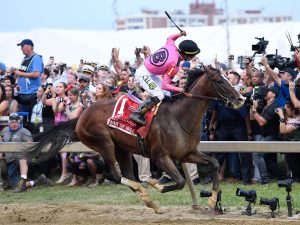By John Furgele

War of Will wins the Preakness Stakes – US Racing Photo
The Kentucky Derby has been moved to the first Saturday … in September. You knew that already, my apologies for repeating and reminding.
As yet, the Preakness and the Belmont have yet to announce their dates. While it would seem logical for the Preakness to run on Saturday, Sept. 19 (two weeks after the Derby) and the Belmont on Saturday, Oct. 10 (three weeks after the Preakness), there are a myriad of reasons why the second two legs of the Triple Crown haven’t fallen into place behind Churchill Downs’ lead.
Simply put, running the Preakness in mid-September and the Belmont on Oct. 10 might not be in their respective tracks’ best interests. More to the point, will mass gatherings of hundreds of thousands of fans be allowed anywhere by the fall? This is especially true in the New York metropolitan area, currently the epicenter of the coronavirus pandemic in the United States.
Further, no one knows how long COVID-19 will delay the NBA, Major League Baseball, MLS, and the NHL. At the very least, a Fall Triple Crown would be competing against college football; throw professional sports into the mix and currently sports-starved fans wouldn’t know what to watch first and networks, which now have nothing, might have too much inventory on their hands.
But things are different. Right about now, trainer Barclay Tagg would be grumbling at the media for annoying him while he geared up Florida Derby (G1) winner Tiz the Law for the May 2 Run for the Roses. But Tagg, Bob Baffert, Steve Asmussen, Chad Brown, Dale Romans and everyone else with a good 3-year-old now faces the challenge of leveling their charges off, and then gearing back up for a fall run to glory.
But, just because the Kentucky Derby has been scheduled for Sept. 5 doesn’t mean it will be run on Sept. 5. If you could guarantee that all three Triple Crown races will be run in the fall, the Bafferts and the Browns and the Romans of the racing world would sign tomorrow — I think.
In the 37-year-long gap between Triple Crown winners (Affirmed in 1978 and American Pharoah in 2015), concerns about the rigorous schedule were voiced again and again. Three races, at three different racetracks, at three different distances, in the space of five weeks, is a tremendous task for a still-developing 3-year-old.
Running the Preakness and the Belmont before the Derby could be an option. It’s been done before (albeit back in the days men still wore fedoras). Triple Crown winner Gallant Fox won the 1930 Preakness two weeks before he won the Derby. (It’s worthwhile to note his son, Omaha, took the Preakness a mere week after the Derby, ran in the Withers on May 27, won the Belmont on June 8 and two weeks later was third against older horses in the Brooklyn Handicap.)
Such a schedule would be unheard of these days, and even running in a summer prep, followed by the Triple Crown races and the Breeders’ Cup Classic would be taxing. That’s five races in roughly 12 to 14 weeks. (Still, somewhere, Conquistador Cielo and Woody Stephens are chuckling, Stephens with a glass of bourbon and Cielo chomping on hay. In 1982, Stephens ran Cielo in the Met Mile and five days later, wheeled him back in the Belmont. He won both races. )
Let it be said that there is nothing wrong with both races being run before the Derby. It might feel weird, but what doesn’t feel weird at this point? If Americans can put on homemade face masks to visit the grocery store, then we can run the Preakness before the Derby and the Belmont before the Preakness. A lot depends on television and sponsorships.
As for too many races in too short of a time, let’s be realistic. No horse will run all three races unless there is a Triple Crown on the line. If the races are run in their traditional order, only the Derby winner is “obligated” to run in the Preakness. The rest can wait until the Belmont or, bypass the rest of the Triple Crown altogether and get ready for the Breeders’ Cup — if they’re good enough.
It depends, of course, on what the owners and trainers want to do. For a horse that runs well in the Derby but comes up short, the Preakness has appeal. Remember Oxbow? He finished sixth in the 2013 Derby, but trainer D. Wayne Lukas felt he was sitting on a big one and two weeks later, he triumphed in Baltimore.
But how many times do we see Derby also-rans skip the Preakness? Also, moving the Triple Crown, with its current timeline, to the fall could negatively impact the Belmont the most. If there is no Triple Crown on the line, what would be the point of a Derby or Preakness winner running 1 ½ miles in the lead up to the Classic?
This could be the year that 20 horses enter the Derby, 13 different horses enter the Preakness and 10 different horses enter the Belmont. And, if that does happen, it won’t take away from the prestige, the excitement and hopefully, the spectacle of a Triple Crown race. These are the American Classics and a win in one of them cements a horse’s legacy.
Patience is a virtue and right now, we need to be as patient as we’ve ever been in our lives. Things will get better, and when it’s better, that’s the time for the Preakness and Belmont to be run.
If you enjoyed this piece, check out other articles at our horse racing news section!

As a kid growing up in the Buffalo suburbs in the 1970s and 80s, the radio was one of John Furgele’s best friends. In the evenings, he used to listen to a show on WBEN radio called “Free Form Sports,” hosted by Buffalo broadcast legend Stan Barron. The show ran weeknights from 6 to 11 pm and featured every kind of sport you could imagine. One minute, Mr. Barron was interviewing a Buffalo Sabres player; the next, he was giving high school field hockey scores.
But there was always one thing that caught John’s ear. During those five hours, Barron would give the results from Western New York’s two harness racing tracks — Buffalo Raceway and Batavia Downs. This is where John learned what exactas, quinellas, trifectas and daily doubles were all about. From then on, he always paid attention to harness racing, and when Niatross (a legendary Western New York horse) hit the scene in 1979, his interest began to blossom.
John believes harness racing is a sport that has the potential to grow and he will explore ways to get that done via marketing, promotion and, above all, the races themselves.
When he’s not watching races, John is busy with his family and his job in sales. Like the pacers and trotters, he does a little running himself and you’ll occasionally find him “going to post” in a local 5K race.


